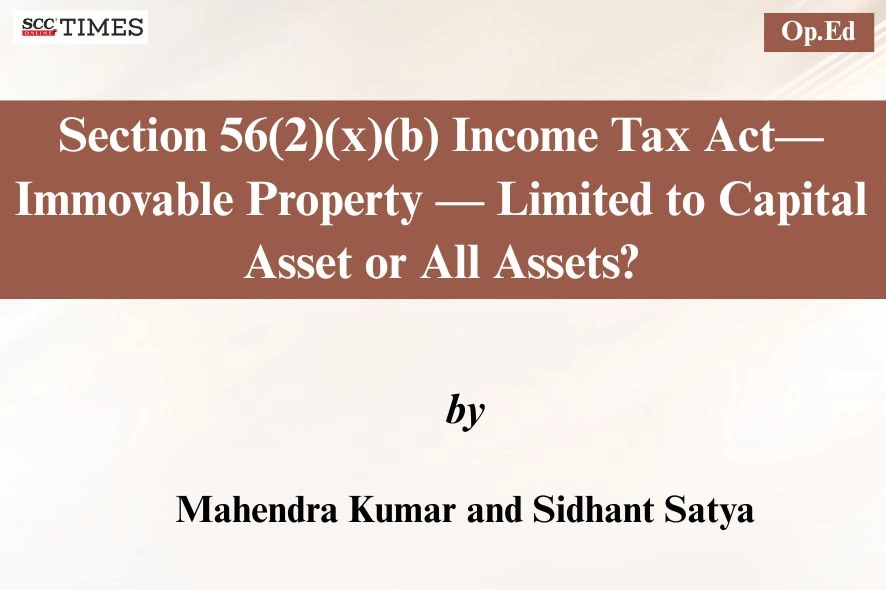The Income-tax Act, 1961, consist various provisions to tax income under various heads of income, including the anti-abuse provision in Section 56(2)(x)1 [erstwhile Section 56(2)(vii)]. The aim of this provision is to prevent tax avoidance, through transfer of an asset, with inadequate consideration or without consideration, by taxing the recipient. Recently, the Income Tax Appellate Tribunals, vide their number of decisions, have dealt with one particular question of fact, i.e. whether the word “immovable property” as enumerated in Section 56(2)(x)(b) includes properties other than the capital asset, i.e. stock in trade or agriculture land situated outside the municipal limits, beyond specified distance (rural agriculture land), as such properties not being capital assets, as defined in Section 2(14)2 of the Act.
The decision of the Ahmedabad Tribunal, in Clay King Minerals LLP3, is in contradiction to the decision of Pune Tribunal, as given in the case of Mubarak Gafur Korabu4 and also of the Jaipur Tribunal in Yogesh Maheshwari5, with respect to applicability of the provisions of Section 56(2)(x)(b) of the Act.
The Ahmadabad Tribunal opined that because “immovable property” has not been defined anywhere in the Act, therefore, in general understanding “immovable property” would include agricultural land also, this is in the absence of any specific exclusion, in the wording of the Section 56(2)(x) of the Act. Thus, sale of rural agricultural land, though, shall not give rise to any capital gains in the hands of the seller, as it is not considered a capital asset itself. However, from the point of view of the “purchaser” of immovable property, as stated above, Section 56(2)(x) mentions “any immovable property” which going by the plain words of the statute, does not specifically exclude “agricultural land”. Also held as under:
“Therefore, in our considered view, going by the plain words of the Section 56(2)(x) of the Act, which uses the term ‘immovable property’, agricultural land cannot be taken out of the purview of Section 56(2)(x) of the Act.”
We will respectfully analyse the jurisprudence set out by the different tribunals and also determine what is the intent of the law, in our opinion, of course.
Definition of property
The Explanation (b) to Section 56(2)(x) of the Act, specifically provides that “expression of property shall have the same meaning as assigned to in clause (d) of explanation of Section 56(2)(vii) of the Act”.
The Explanation (d) to Section 56(2)(vii)6 states “property” means the following capital asset of the assessee, namely:
(i) immovable property being land or building or both;
(ii) shares and securities;
(iii) jewellery;
(iv) archaeological collections;
(v) drawings;
(vi) paintings;
(vii) sculptures;
(viii) any work of art; or
(ix) bullion;
The agricultural land does not appear in this list of assets. It lists only specific capital assets and excludes others. This is an exhaustive definition, not an inclusive one.
By the literal interpretation, it means that the revenue cannot levy tax under Section 56, Income-tax Act, 1961, on “stock in trade” and “rural agriculture land”, by invoking provisions of Section 56(2)(x) of the Act, as this was never the intent of the legislature.
Expressio Unius Est Exclusio Alterius: By expressly naming only few capital assets in the definition of “property” under Section 56(2)(x) of the Act, the intention of the Parliament is very clear. If the intention was to include all assets, then the law would have been drafted like that way.
Rural agricultural land: Specifically excluded
The definition of capital asset, as given in Section 2(14) of the Act, specifically excludes rural agricultural land situated in India from its ambit.
Since Section 56(2)(x) of the Act, applies only to “capital assets” that fall within its exhaustive list, rural agricultural land, not being a capital asset, is outside its scope.
If Parliament intended to tax all land transfers, it would have removed the dependency on the definition of capital asset in Section 2(14) of the Act. By retaining the reference, it shows a conscious choice to exclude rural agricultural land.
Related provisions
Provisions of Section 56(2)(x) of the Act, applies on three types of properties, namely,
(i) any sum of money;
(ii) any immovable property; and
(iii) any property other than immovable property.
Therefore, it appears that Ahmedabad Tribunal, in its decision, has confined itself in limiting the meaning of immovable property under sub-head (b), however, first proviso of clause (x) specifically provides that this clause shall not apply to any sum of money or any property received from or by certain persons or under certain circumstances. Thus, the Section 56(2)(x) of the Act, is applicable per se recipient or buyer with reference to sum or property limited to capital asset may be movable or immovable.
Consequential effect
Where Section 56(2)(x) of the Act, is invoked in case of capital asset, there is mechanism to increase the cost of property under Section 49(4)7 of the Act by amount charged under Section 56(2)(x) to avoid double taxation, when subsequent sale occurs of such property. However, there is no such mechanism to increase value of stock when property being immovable property is acquired below Stamp Duty Value but on the other side on occasion of sale, cascading effect is covered by provision of Section 43-CA8. Further, where rural agricultural land purchased below Stamp Duty Value no need to increase cost by such difference, since subsequent sale of such rural agricultural land is again exempt.
Law of impossibility
If there is any dispute as regard to valuation of rural agriculture land with respect to actual consideration and Stamp Duty Value, then the valuation has to be referred under Section 50-C(2) of the Act, but the said section specifically talks about the valuation of capital asset. Now, if it was the intent of the lawmakers to include property being non-capital asset, then the word capital asset would not have been legislated.
Separate treatment under the Act
Capital assets are otherwise taxed under the head capital gains. Where assets are transferred for inadequate consideration, then, the provisions of sections like Sections 50-C, 50-CA, and 50-D9, shall apply. Section 56(2)(x) is not intended to overlap but to plug gaps only for the specified assets at the end of buyer or recipient.
Without prejudice to above, the question may arise as to why immovable property is provided under clause (b) and the clear intent of the lawmakers to include that is because bifurcation, given under Section 56(2)(x)(a), (b) and (c), where (a) talks about any sum received; (b) talks about immovable property; and (c) talks about movable property. It also provides different rules for them while computing deeming income on the basis of Stamp Duty Value for immovable property and Fair Market Value for movable property.
That is why the lawmakers felt to make the clear distinction between the different types of property and the sum, i.e. received.
Consistency across tax provisions
Rural agricultural land enjoys consistent exemptions elsewhere:
(a) excluded from capital gains taxation [Section 2(14)]; and
(b) not covered by Section 50-C deeming provisions.
To include it in Section 56(2)(x) would contradict this scheme of neutrality.
Conclusion
As per our understanding the definition of “property” in clause (d) of explanation of Section 56(2)(vii) is exhaustive. Therefore, provisions of Section 56(2)(x)(b) is applicable on immovable property, which is a “capital asset”, and can also be applied on agricultural land, if the said land is a “capital asset”, as defined in Section 2(14) of the Act.
*Chartered Accountant. Author can be reached at: satyaandsatya4@gmail.com.
**Law Student. Author can be reached at: satyaandsatyas@gmail.com.
1. Income-tax Act, 1961, S. 56(2)(x).
2. Income-tax Act, 1961, S. 2(14).
3. Clayking Minerals LLP v. CIT, 2025 SCC OnLine ITAT 13548.
4. Mubarak Gafur Korabu v. CIT, 2019 SCC OnLine ITAT 9691.
5. Yogesh Maheshwari v. CIT, 2021 SCC OnLine ITAT 1490.
6. Income-tax Act, 1961, S. 56(2)(vii) Explanation (d).
7. Income-tax Act, 1961, S. 49(4).
8. Income-tax Act, 1961, S. 43-CA.



